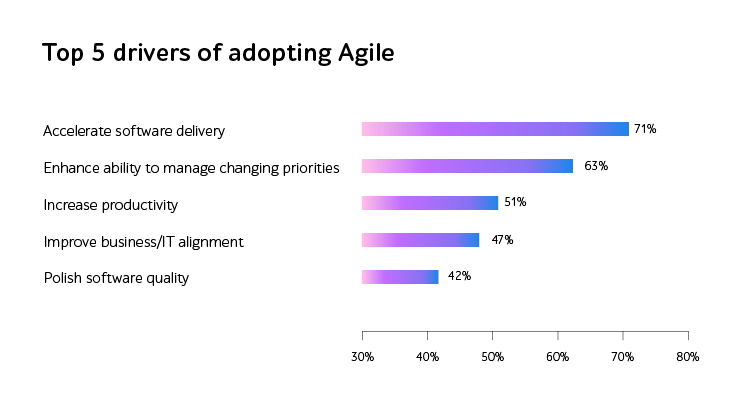
How to handle the uncertainty with Agile: three-phase game plan
We are witnessing that companies keep on combatting the “black swan” impact on people and operations while ensuring business continuity.
This is why the market players are facing the crisis with a spirit of reinventing business strategies — speeding up digital transformation and introducing Agile-based processes.
So let me tell you a bit about what to do to streamline achieving business resilience and discuss a three-phase strategy to make the most of Agile.
Phase #1. Implement Agile values
While intending to address the uncertainty through Agile practices, ask yourself a question, “What set of values should I apply to the IT projects?”
Agile Manifesto provides the following ones:
Put individuals and communication over tools and processes
The thoroughly chosen team with the right skillset is one of the clues to business success, as the best possible tools in the wrong hands are worthless.
Another point here is providing smooth communication between the project’s members. With right-skilled people relying on mutual support and a sense of cohesion, one can move heaven and earth on the projects contributing to solving almost any issue.
Being correctly motivated, the team cares about results and considers business objectives as their own — a true team mindset in action.
Focus on working software rather than the documentation
Time passes, priorities are changing, and bureaucracy with a massive volume of paperwork is taking a back seat. For now, proper software operation allows companies to maintain business resilience and enhance brand image, so ensured high quality is amid top priorities.
That doesn’t mean tech requirements, software specifications, test plans, quality reports, etc. are not relevant. It means that by constantly optimizing documents handling, specialists apply fewer efforts while enabling total transparency and visibility of the project’s activities helping effectively organize and monitor IT processes.
Collaborate with clients more than the contract stipulates it
Interacting with clients is more than just a legal agreement. Delving deeply into customers’ needs, their working approach and mindset — these all are about fruitful relationships. And a long-lasting partnership.
What’s more, this value focuses on continuously developing and testing to release software faster and more frequently while keeping ongoing collaboration between a customer and a project manager.
Apply dynamic roadmap instead of static plan
Adaptability. When everything is shifting drastically in a matter of a second, then strictly following the plan can be pointless, especially in terms of uncertainty.
Unstable market conditions and swift changes in customers’ behavior patterns mostly determine the actions the C-board performs while defining a strategy in case of an emergency.
This is where IT managers apply Agile practices with short iterations and continuous software delivery at the core that help speed up time to market, manage priorities, and meet ever-evolving market requirements and end-user expectations.
Please have a look at some drivers of introducing Agile shared by the 14th Annual State of Agile Report.

Source: the 14th Annual State of Agile Report
Phase #2. Reap benefits of flexible methodologies
Time zips along and technologies are constantly evolving. So, it’s getting more difficult to satisfy customers — high software quality and stable functioning are taken for granted, of course.
Agile practices allow companies to add newly developed features into the IT product at short notice while contributing to strengthening customer loyalty and enticing new users.
Having become a concurrent part of the software development process, software testing enlarges the SDLC and, in some cases, slows down the delivery time. Despite that, adaptable methodologies accelerate t2m by streamlining IT and QA activities. It assumes the possibility to promptly respond to emerging issues, change priorities, and adjust to the ever-changing IT market.
Within sustainable software development and testing and continuous support between project’s associates, Agile is an exceptional assistant in winning the competition that enable early and frequent releases of IT products.
Phase #3. Apply Agile best practices
With the steady evolution of the IT market and the merging of software testing and development, Agile is also modifying and providing new approaches for the needs of any business.
The World Quality Report (WQR) 2020-2021 states that a higher percentage of respondents over last year have shifted to flexible methodologies while allocating 30% of their overall project efforts to QA.
Why so? To delight end users.
For instance, DevOps assumes continuous testing with the concepts of testing early, testing as often as possible, and testing at all stages of the life cycle with automation excellence. With that, it provides regular code updates, enables quick code roll-out after that, and reduces the testing cycle time while helping avoid expensive bug fixing after going live.
Tending to detect defects from the very project start, companies are applying shift left testing. More than half of the WQR respondents onboard QA specialists at the early SDLC stages and embark on QA activities at the planning phase. Preliminary reviewing documentation helps fix possible discrepancies before the code is prepared.
SAFe, for example, provides not only alignment between teams, but also to all levels of the enterprise that are involved in solution development. With that, the framework drives faster time to benefits, increased software productivity and quality, and higher customer engagement.
Therefore, by introducing any of adaptable practices, one ensures cost-effective software development while guaranteeing high quality of IT solutions and building trusting relationships with stakeholders, customers, and team members.
The takeaway points
In unstable times, it’s my opinion that agility as a mindset helps concentrate on people, provide early feedback, tune interaction, and deliver regular course adjustments.
By introducing this Agile three-step game plan — implement values, reap benefits, apply best practices — companies undergo the difficulties as well as strengthen competitive advantage.
Contact us to discuss how your company can improve the software quality through Agile.









